Hot Bamboo Massage
Hot bamboo massage is a therapeutic technique where warmed bamboo sticks are used to massage the body. The bamboo sticks are heated to a comfortable temperature and then rolled, kneaded, and pressed onto the muscles, providing a unique and deeply relaxing experience.
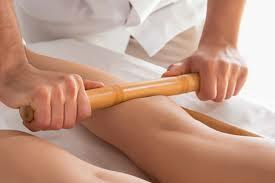
Benefits of hot bamboo massage include:
- Muscle relaxation: The heat from the bamboo sticks helps to relax tense muscles, reducing stiffness and promoting flexibility.
- Improved circulation: The massage strokes with the bamboo sticks can help improve blood circulation, which can aid in the delivery of oxygen and nutrients to the muscles and tissues.
- Release of tension: The pressure applied with the bamboo sticks can release tension and knots in the muscles, relieving pain and discomfort.
- Stress reduction: The combination of heat and massage promotes relaxation, helping to reduce stress and promote overall well-being.
- Lymphatic drainage: The rhythmic movements of the bamboo sticks can stimulate the lymphatic system, aiding in detoxification and reducing swelling.
- Exfoliation: In some cases, the bamboo sticks may be used to gently exfoliate the skin, leaving it smooth and rejuvenated.
Overall, hot bamboo massage offers a therapeutic and luxurious experience that can address both physical and mental tension, promoting relaxation and healing.
Deep Tissue Massage
Deep tissue massage is a therapeutic massage technique that focuses on realigning deeper layers of muscles and connective tissue. It involves applying sustained pressure using slow, deep strokes to target specific areas of tension and discomfort in the body.

The benefits of deep tissue massage include:
- Pain relief: Deep tissue massage can help alleviate chronic pain conditions such as back pain, neck pain, and muscle tension by releasing tightness and knots in the muscles.
- Improved mobility: By targeting deeper layers of muscle tissue, deep tissue massage can help improve flexibility and range of motion in joints, making movement easier and more comfortable.
- Reduction of muscle tension: The deep pressure applied during the massage helps to break up adhesions and scar tissue, releasing built-up tension and restoring muscle function.
- Enhanced circulation: Deep tissue massage can improve blood circulation, which helps deliver oxygen and nutrients to the muscles and remove metabolic waste products, promoting overall tissue health.
- Reduction of inflammation: Deep tissue massage can help reduce inflammation in the body by increasing blood flow and lymphatic drainage, which can alleviate symptoms of conditions such as arthritis and tendonitis.
- Stress relief: While deep tissue massage can be intense, it can also promote relaxation and stress relief by triggering the release of endorphins, the body’s natural painkillers, and reducing levels of stress hormones such as cortisol.
- Breakdown of scar tissue: Deep tissue massage can help break down scar tissue and adhesions from injuries or surgeries, improving mobility and reducing discomfort.
Overall, deep tissue massage can be an effective treatment for addressing chronic pain, muscle tension, and mobility issues, while also promoting relaxation and overall well-being. It is important to communicate with your massage therapist during the session to ensure that the pressure is appropriate and comfortable for you.

Relaxation (Swedish) Massage
Relaxation massage, also known as Swedish massage, is a gentle and soothing massage technique aimed at promoting relaxation and reducing stress. It typically involves long, flowing strokes, kneading, and gentle circular movements applied with varying pressure to the muscles and soft tissues of the body.
The benefits of relaxation massage include:
- Stress reduction: Relaxation massage helps to calm the nervous system and reduce levels of stress hormones such as cortisol, promoting a sense of relaxation and overall well-being.
- Muscle relaxation: The gentle strokes and kneading movements of relaxation massage help to release tension and tightness in the muscles, promoting muscle relaxation and reducing muscle stiffness.
- Improved circulation: Relaxation massage can improve blood and lymphatic circulation, which helps deliver oxygen and nutrients to the body’s tissues and remove metabolic waste products, promoting overall tissue health.
- Pain relief: While relaxation massage is not specifically designed to target chronic pain conditions, it can help alleviate minor aches and pains by promoting muscle relaxation and reducing tension.
- Enhanced mood: Relaxation massage can help stimulate the release of endorphins, the body’s natural feel-good hormones, which can improve mood and promote a sense of well-being.
- Better sleep: The calming effects of relaxation massage can help improve sleep quality by promoting relaxation, reducing stress, and easing muscle tension, allowing for a more restful night’s sleep.
- Immune system support: Some studies suggest that relaxation massage may help support the immune system by reducing stress and promoting relaxation, which can have positive effects on immune function.
Overall, relaxation massage offers a gentle and nurturing experience that can help promote relaxation, reduce stress, and improve overall well-being. It is suitable for individuals of all ages and can be a valuable addition to a regular self-care routine.

Marma Point Massage
Marma points massage is a traditional Ayurvedic technique that involves applying pressure to specific energy points on the body known as Marma points. These points are believed to be vital energy centers where physical, mental, and emotional energies converge. Marma points are similar to acupressure points in traditional Chinese medicine but in fact this technique is a lot older and takes its roots from ancient Indian school of Vedic knowledge
Benefits of marma points massage include:
- Balancing energy flow: By stimulating marma points, the massage helps to balance the flow of energy (prana) throughout the body, promoting overall well-being and vitality.
- Relief from pain and discomfort: Pressure applied to marma points can help alleviate various types of pain, including headaches, joint pain, and muscle tension.
- Stress reduction: Marma points massage can induce a deep sense of relaxation, reducing stress and promoting mental clarity and emotional balance.
- Improvement in circulation: Stimulating marma points can enhance blood circulation, which supports the delivery of oxygen and nutrients to tissues and organs, as well as the removal of toxins.
- Enhanced detoxification: Activation of marma points can aid in the detoxification process by promoting the elimination of waste and toxins from the body.
- Boosting immunity: Balancing the flow of energy through marma points is believed to strengthen the body’s natural defense mechanisms, thus supporting overall immune function.
- Improved sleep: Marma points massage can help calm the mind and relax the body, promoting better sleep quality and duration
Overall, marma points massage offers a holistic approach to wellness by addressing physical, mental, and emotional imbalances, promoting harmony and vitality throughout the body.

Kizhi Massage
Kizhi massage is a traditional Ayurvedic therapy originating from India. It involves the use of heated herbal pouches, typically filled with a combination of herbs, grains, and medicinal plants. These pouches are pressed and massaged onto the body, focusing on specific areas or the entire body.
The benefits of Kizhi massage include:
- Pain relief: The warmth and pressure from the herbal pouches can help alleviate muscle and joint pain, including arthritis and back pain.
- Improved circulation: The massage promotes better blood flow, which can enhance oxygen and nutrient delivery to tissues and organs.
- Detoxification: The combination of herbs and heat can aid in the elimination of toxins from the body.
- Relaxation and stress reduction: The soothing warmth and gentle pressure induce relaxation, reducing stress and promoting overall well-being.
- Enhanced skin health: The herbs used in the pouches may have skin-nourishing properties, improving skin texture and tone.
Overall, Kizhi massage offers a holistic approach to wellness, addressing both physical and mental health aspects. However, individual experiences may vary, and it’s essential to consult a qualified practitioner before undergoing any Ayurvedic therapy.

Russian Sports Massage
Russian sports massage, also known as Russian sports massage therapy or Russian sports massage techniques, is a form of therapeutic massage that originated in Russia and is widely used to enhance athletic performance and aid in recovery. It combines elements of traditional sports massage with techniques derived from Russian medical massage and physical therapy.
Benefits of Russian sports massage include:
- Improved flexibility and range of motion: Russian sports massage employs dynamic stretching techniques and deep tissue manipulation to increase flexibility and mobility in muscles and joints, helping athletes achieve optimal performance.
- Enhanced circulation: The massage techniques used in Russian sports massage stimulate blood flow to the muscles, which helps deliver oxygen and nutrients while removing metabolic waste products, reducing muscle fatigue, and speeding up recovery.
- Injury prevention: By targeting specific muscle groups and addressing areas of tension and imbalance, Russian sports massage can help prevent injuries by promoting proper muscle alignment and function.
- Pain relief: Russian sports massage utilizes deep tissue manipulation to alleviate muscle soreness, tension, and discomfort caused by intense physical activity or overuse injuries.
- Reduced muscle stiffness: The combination of massage techniques, including effleurage, petrissage, and tapotement, helps relax tight muscles and release muscle spasms, reducing stiffness and improving flexibility.
- Faster recovery: Russian sports massage accelerates the body’s natural healing process by promoting lymphatic drainage, which reduces swelling and inflammation, and by increasing circulation, which delivers essential nutrients to damaged tissues.
- Psychological benefits: In addition to its physical benefits, Russian sports massage can also have psychological benefits by reducing stress, anxiety, and tension, promoting relaxation, and enhancing overall well-being.
Overall, Russian sports massage is a comprehensive approach to sports therapy that addresses the unique needs of athletes and active individuals, helping them achieve peak performance, prevent injuries, and recover faster from intense physical activity.
Abhyanga Massage
Abhyanga massage is an ancient Ayurvedic practice originating from India that involves the application of warm oil to the body in a rhythmic and flowing manner. Typically, herbal oils are used, chosen based on the individual’s constitution or specific health needs. The massage is performed with long, sweeping strokes and gentle pressure, focusing on the entire body, including the joints and pressure points.
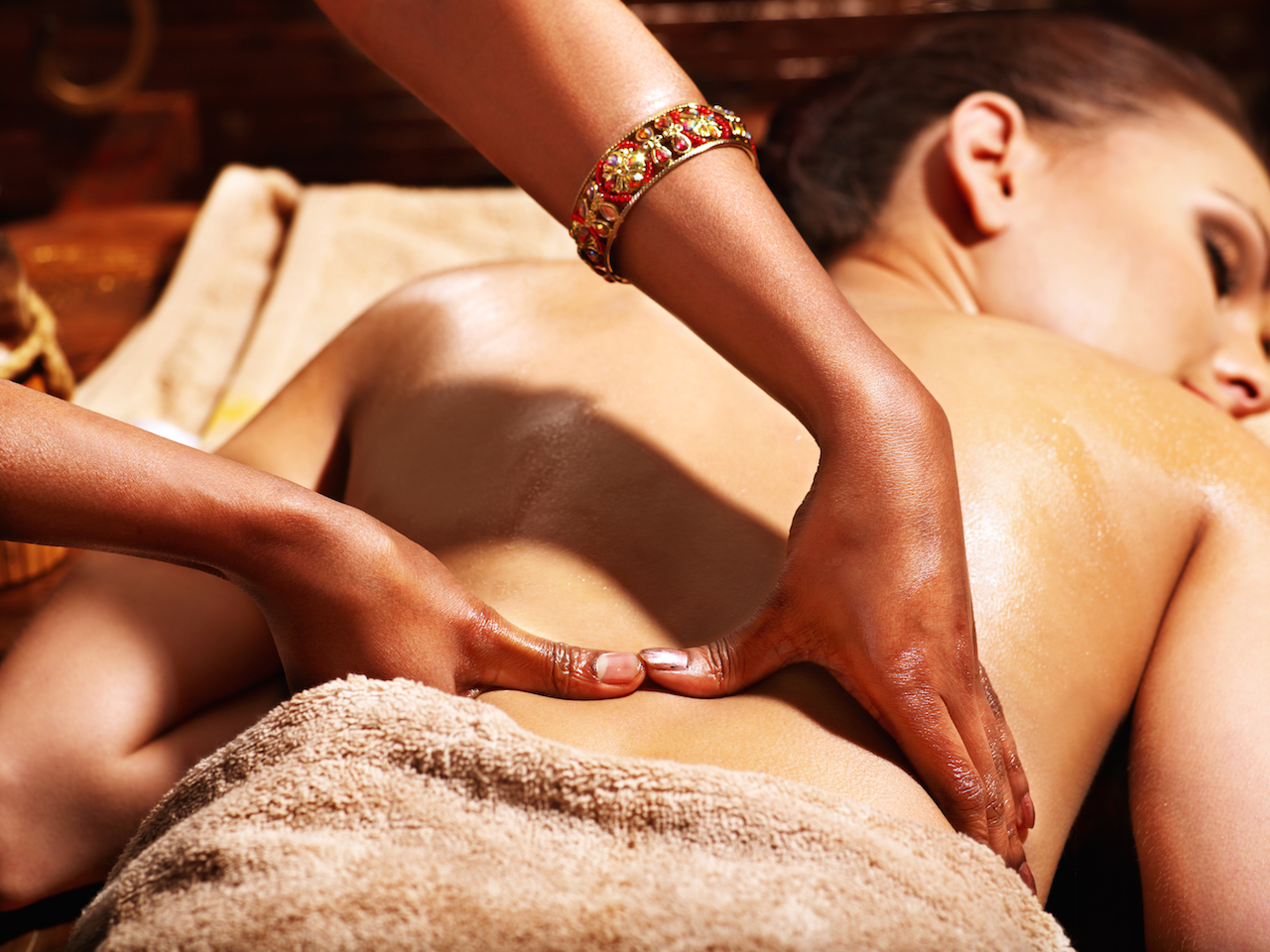
The benefits of abhyanga massage include:
- Nourishing the skin: The warm oil penetrates the skin, moisturizing and nourishing it, resulting in improved skin texture and appearance.
- Relaxation and stress relief: The rhythmic massage strokes and the soothing warmth of the oil help to relax the muscles and calm the nervous system, promoting a sense of deep relaxation and stress relief.
- Detoxification: The massage stimulates the lymphatic system, aiding in the removal of toxins from the body and supporting overall detoxification.
- Improved circulation: The gentle massage strokes help to improve blood circulation, which can enhance the delivery of oxygen and nutrients to the body’s tissues and organs.
- Balancing the doshas: According to Ayurveda, abhyanga massage can help balance the three doshas (Vata, Pitta, and Kapha), promoting overall health and well-being.
- Joint mobility: The massage helps to lubricate the joints, improving flexibility and mobility.
Overall, abhyanga massage is not only a physical therapy but also a deeply rejuvenating and balancing practice for the body, mind, and spirit.
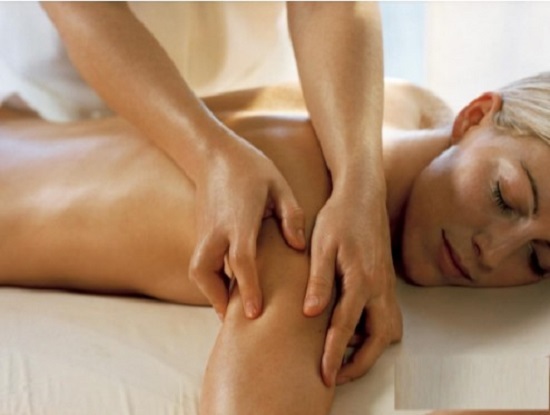
Lymphatic Drainage Massage
Lymphatic drainage massage is a gentle, therapeutic technique designed to stimulate the lymphatic system, which is responsible for removing waste and toxins from the body, as well as supporting the immune system. During the massage, light pressure and rhythmic movements are applied to specific areas of the body to encourage the flow of lymph fluid.
The benefits of lymphatic drainage massage include:
- Improved lymphatic circulation: The massage helps to stimulate the movement of lymph fluid through the lymphatic vessels, facilitating the removal of toxins, excess fluid, and waste products from the body.
- Reduced swelling and edema: By promoting lymphatic circulation, the massage can help reduce swelling and edema, particularly in areas prone to fluid retention, such as the legs, ankles, and arms.
- Detoxification: Lymphatic drainage massage supports the body’s natural detoxification process by assisting in the removal of metabolic waste and toxins from the tissues.
- Enhanced immune function: A healthy lymphatic system is essential for a strong immune response. By improving lymphatic circulation, the massage can help boost immune function and support the body’s ability to fight off infections and illness.
- Relief from inflammation: The gentle, rhythmic movements of lymphatic drainage massage can help reduce inflammation in the body, providing relief from conditions such as arthritis, sinusitis, and inflammatory skin conditions.
- Relaxation and stress relief: Like other forms of massage, lymphatic drainage massage can promote relaxation and stress relief, helping to calm the nervous system and promote a sense of well-being.
Overall, lymphatic drainage massage is a gentle and effective therapy that offers a range of benefits for both physical and emotional well-being. It is particularly beneficial for individuals dealing with issues related to lymphatic congestion, swelling, or compromised immune function.
Cold Brushing Massage
Cold brushing massage, also known as dry brushing, involves using a dry brush with stiff bristles to gently massage the skin in upward strokes. Unlike other massages that use oils or lotions, dry brushing is performed on dry skin. The brush strokes are typically directed towards the heart to promote lymphatic drainage and circulation.

The benefits of cold brushing massage include:
- Exfoliation: Dry brushing helps to remove dead skin cells from the surface of the skin, leaving it smoother and softer. This can improve the skin’s texture and appearance.
- Stimulated circulation: The brushing action stimulates blood flow to the skin, which can help improve circulation and promote the delivery of oxygen and nutrients to the skin cells.
- Lymphatic drainage: Dry brushing can help stimulate the lymphatic system, which is responsible for removing toxins and waste products from the body. By promoting lymphatic drainage, dry brushing may help reduce swelling and improve overall detoxification.
- Reduced cellulite: Some proponents of dry brushing claim that it can help reduce the appearance of cellulite by breaking down fatty deposits and improving circulation in the affected areas. However, more research is needed to support this claim.
- Invigorating sensation: The brushing action can create a stimulating and invigorating sensation on the skin, helping to awaken the senses and boost energy levels.
- Improved skin tone: Regular dry brushing may help improve the tone and firmness of the skin by promoting circulation and collagen production.
Overall, cold brushing massage can be a simple yet effective way to improve the health and appearance of the skin, promote circulation, and support detoxification. It is often recommended as part of a regular skincare routine for its exfoliating and stimulating effects.
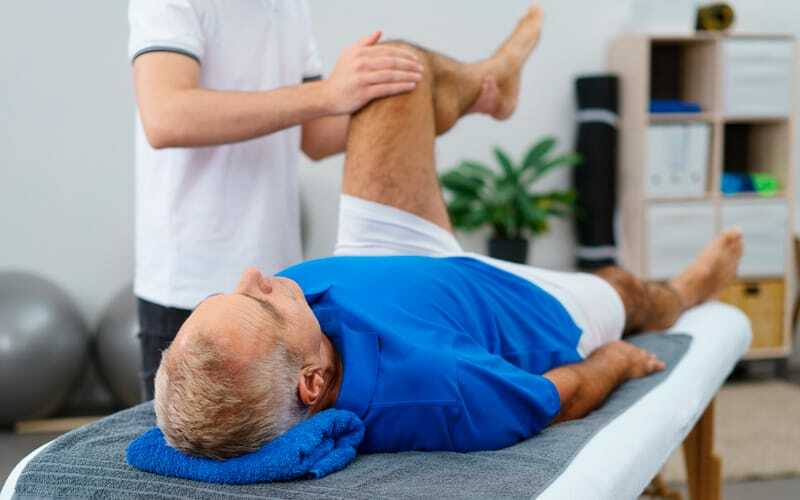
Passive Stretching
Passive stretching is a form of stretching where an external force, such as a partner, a stretching device, or gravity, is used to move a joint or muscle beyond its usual range of motion. Unlike active stretching, where the individual uses their own muscles to move into a stretch, passive stretching involves relaxation of the muscles being stretched while an external force applies the stretch.
The benefits of passive stretching include:
- Improved flexibility: Passive stretching helps to elongate and lengthen muscles, tendons, and connective tissue, which can lead to increased flexibility and range of motion in joints.
- Reduced muscle tension: By allowing the muscles to relax and elongate, passive stretching can help reduce muscle tension and stiffness, promoting relaxation and stress relief.
- Enhanced recovery: Passive stretching can be used as part of a post-workout recovery routine to help alleviate muscle soreness and prevent muscle imbalances.
- Injury prevention: Regular passive stretching can help improve joint mobility and flexibility, reducing the risk of injury during physical activity or everyday movements.
- Improved posture: Passive stretching can target tight muscles that may contribute to poor posture, helping to lengthen and release tension in these muscles and promote better alignment.
- Increased circulation: Passive stretching can improve blood flow to the muscles, which can help deliver oxygen and nutrients to the tissues and remove metabolic waste products, promoting overall muscle health.
- Relaxation and stress relief: The gentle stretching movements and relaxation involved in passive stretching can have a calming effect on the nervous system, promoting relaxation and reducing stress.
Overall, passive stretching can be a valuable component of a well-rounded fitness or rehabilitation program, helping to improve flexibility, prevent injury, and promote overall muscle health and relaxation.
Deep Tissue Facial Sculpting Massage
Deep tissue facial massage is a therapeutic technique that involves applying firm pressure and fast intense strokes to the facial muscles and connective tissues. Unlike traditional facial massages, which focus on gentle, relaxing strokes, deep tissue facial massage targets deeper layers of muscle and jowls tissue to address tension and promote relaxation.

Deep tissue facial sculpting massage is a specialized technique that targets the deeper layers of facial muscles and connective tissues. Let’s delve into the process and benefits:
- Process:
- Technique: The therapist uses firm pressure and slow strokes to reach the underlying facial muscles and fascia.
- Areas Targeted: It focuses on specific areas, such as the jawline, cheekbones, forehead, and neck.
- Intra-oral Component (Buccal Massage): Some variations include intra-oral work, where the therapist gently massages inside the mouth to release tension in the buccal pad (a fat pouch between the cheekbone and jaw).
- Stimulation and Manipulation: The therapist stimulates blood circulation, encourages cellular turnover, and promotes lymphatic flow.
- Customization: The massage can be customized based on individual needs and concerns.
- Benefits:
- Facial Sculpting and Contouring:
- Defines and lifts facial features.
- Enhances cheekbones, jawline, and overall facial symmetry.
- Relaxation and Stress Reduction:
- Releases muscle tension and knots.
- Provides a sense of relaxation and well-being.
- Improved Blood Circulation:
- Boosts oxygen and nutrient supply to skin cells.
- Aids in detoxification.
- Lymphatic Drainage:
- Helps remove excess fluid and toxins.
- Reduces puffiness and swelling.
- Natural Facelift Effect:
- Over time, consistent sessions may contribute to a more youthful appearance.
- Release of Muscular Spasms:
- Alleviates discomfort caused by tight facial muscles.
- Enhanced Skin Health:
- May improve skin texture, tone, and radiance.
- Facial Sculpting and Contouring:
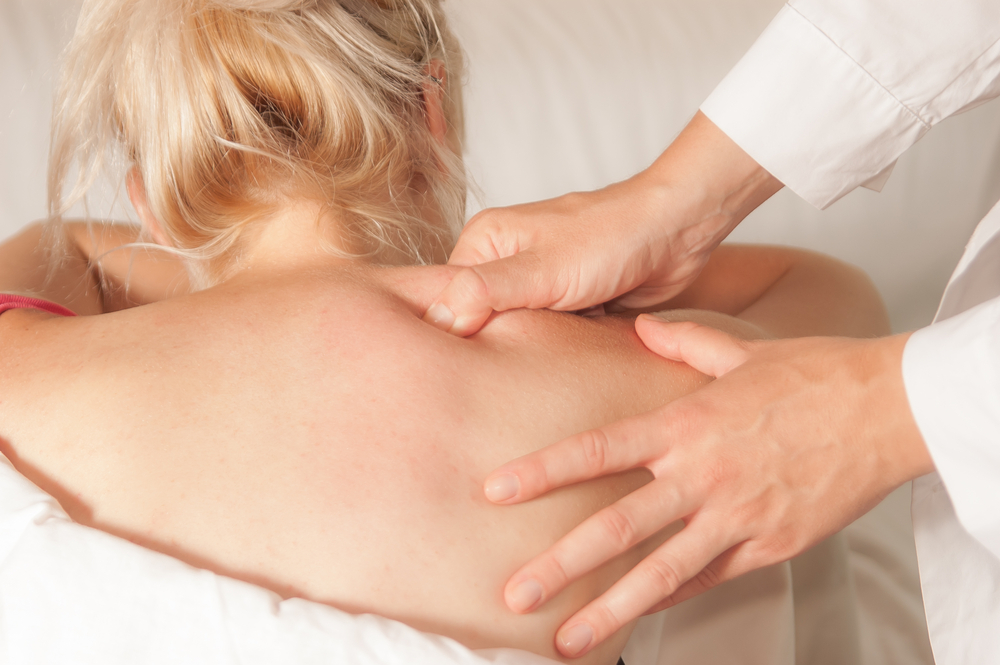
Trigger Point Massage
Trigger point massage is a therapeutic technique that focuses on identifying and releasing trigger points, which are areas of muscle tightness and tenderness that can cause referred pain and discomfort in other parts of the body. During a trigger point massage, the therapist applies direct pressure to these points to release tension and alleviate pain.
The benefits of trigger point massage include:
- Pain relief: Trigger point massage can help relieve chronic pain conditions such as tension headaches, neck pain, and lower back pain by releasing tight muscles and reducing referred pain.
- Improved range of motion: By releasing tension in the muscles, trigger point massage can improve flexibility and range of motion in joints, making movement easier and more comfortable.
- Reduced muscle tension: Trigger point massage helps to break up adhesions and knots in the muscles, allowing them to relax and function more efficiently.
- Relief from muscle spasms: Trigger point massage can help reduce muscle spasms and cramps by releasing tightness and restoring proper muscle function.
- Improved circulation: The pressure applied during trigger point massage helps to increase blood flow to the muscles, promoting the delivery of oxygen and nutrients and aiding in the removal of metabolic waste products.
- Stress relief: Like other forms of massage, trigger point massage can promote relaxation and stress relief by triggering the release of endorphins, the body’s natural painkillers, and reducing levels of stress hormones such as cortisol.
- Prevention of future injuries: By addressing areas of muscle tightness and tension, trigger point massage can help prevent future injuries and improve overall muscle health and function.
Overall, trigger point massage can be an effective treatment for addressing chronic pain, muscle tension, and mobility issues, while also promoting relaxation and overall well-being. It is important to communicate with your massage therapist during the session to ensure that the pressure is appropriate and comfortable for you.
Prenatal Massage
Prenatal massage is a therapeutic massage tailored specifically to the needs of pregnant women. It is performed by a trained massage therapist who is knowledgeable about the anatomical and physiological changes that occur during pregnancy. Prenatal massage typically involves gentle, nurturing techniques that help alleviate discomfort and promote relaxation for expecting mothers.

The benefits of prenatal massage include:
- Relief from muscle tension and discomfort: Prenatal massage can help relieve common pregnancy-related discomforts such as lower back pain, sciatic nerve pain, hip pain, and leg cramps by addressing muscle tension and tightness.
- Reduced stress and anxiety: The calming effects of prenatal massage can help reduce stress and anxiety levels in expectant mothers, promoting a sense of relaxation and well-being.
- Improved sleep: Prenatal massage can help improve sleep quality by promoting relaxation and reducing discomfort, allowing pregnant women to get better rest during pregnancy.
- Decreased swelling: Prenatal massage techniques, such as gentle strokes and lymphatic drainage, can help reduce swelling (edema) in the hands, feet, and ankles, which is common during pregnancy.
- Enhanced circulation: Prenatal massage can improve blood and lymphatic circulation, which helps deliver oxygen and nutrients to the body’s tissues and remove waste products, benefiting both the mother and the baby.
- Preparation for labor and childbirth: Some studies suggest that prenatal massage may help prepare the body for labor and childbirth by promoting relaxation, reducing pain perception, and improving overall well-being.
- Bonding with the baby: Prenatal massage provides an opportunity for expectant mothers to connect with their growing baby in a nurturing and supportive environment, promoting a sense of bonding and connection.
Overall, prenatal massage can be a safe and effective way for pregnant women to alleviate discomfort, reduce stress, and promote overall well-being during pregnancy. It is important for pregnant women to consult with their healthcare provider before receiving prenatal massage and to seek treatment from a qualified and experienced massage therapist trained in prenatal massage techniques.
Therapeutic Massage
Therapeutic massage encompasses various techniques tailored to address specific health concerns or conditions. Unlike relaxation massage, which primarily focuses on promoting relaxation and reducing
stress, therapeutic massage aims to alleviate pain, improve mobility, and enhance overall physical well-being through targeted techniques.

The benefits of therapeutic massage depend on the specific techniques used and the individual’s needs but may include:
- Pain relief: Therapeutic massage can help alleviate acute and chronic pain conditions such as muscle strains, tension headaches, back pain, and arthritis by reducing muscle tension, improving circulation, and promoting relaxation.
- Improved mobility: Therapeutic massage techniques, such as myofascial release, trigger point therapy, and deep tissue massage, can help improve flexibility, range of motion, and joint mobility by releasing tight muscles and restoring proper alignment.
- Injury recovery: Therapeutic massage can aid in the recovery process from sports injuries, accidents, surgeries, and other musculoskeletal injuries by reducing inflammation, promoting tissue healing, and preventing scar tissue formation.
- Stress reduction: While therapeutic massage primarily focuses on addressing physical health concerns, it can also have stress-relieving benefits by promoting relaxation, reducing muscle tension, and triggering the release of endorphins, the body’s natural painkillers.
- Enhanced circulation: Therapeutic massage techniques, such as effleurage and petrissage, can help improve blood and lymphatic circulation, which aids in the delivery of oxygen and nutrients to the body’s tissues and removes metabolic waste products.
- Improved posture: Therapeutic massage can help correct postural imbalances, reduce muscular compensations, and alleviate muscle tension associated with poor posture, resulting in improved alignment and overall posture.
- Mental and emotional well-being: Therapeutic massage can have positive effects on mental and emotional health by promoting relaxation, reducing stress and anxiety levels, and improving overall mood and well-being.
Overall, therapeutic massage offers a holistic approach to addressing a wide range of physical health concerns, promoting relaxation, pain relief, and overall well-being. It is often used as part of a comprehensive treatment plan in conjunction with other modalities such as physical therapy, chiropractic care, and acupuncture.

Hot Stone Massage
Hot stone massage is a therapeutic massage technique that involves the use of heated stones placed on specific areas of the body and used by the massage therapist to perform massage strokes. The stones are typically smooth, flat, and made of basalt, a volcanic rock that retains heat well.
During a hot stone massage, the therapist may place heated stones along the spine, in the palms of the hands, between the toes, or on other specific points of the body. The stones may also be used to perform massage strokes such as gliding, kneading, and circular movements, applying gentle pressure to the muscles.
The benefits of hot stone massage include:
- Muscle relaxation: The heat from the stones helps to relax and soothe tight muscles, allowing the massage therapist to perform deeper massage strokes and alleviate muscle tension more effectively.
- Stress reduction: The combination of heat and massage promotes relaxation, reduces stress levels, and calms the nervous system, helping to induce a state of deep relaxation and well-being.
- Improved circulation: The heat from the stones dilates blood vessels, increasing blood flow to the muscles and tissues, which helps deliver oxygen and nutrients and remove metabolic waste products more efficiently.
- Pain relief: Hot stone massage can help alleviate chronic pain conditions such as back pain, arthritis, and fibromyalgia by reducing muscle tension, improving circulation, and promoting relaxation.
- Enhanced mental and emotional well-being: The warmth and comforting sensation of hot stone massage can have positive effects on mental and emotional health, promoting a sense of comfort, security, and relaxation.
- Detoxification: The heat from the stones can help stimulate the lymphatic system, promoting the removal of toxins and waste products from the body and supporting overall detoxification.
- Improved sleep: Hot stone massage can help improve sleep quality by promoting relaxation, reducing stress levels, and alleviating muscle tension, allowing for a more restful night’s sleep.
Overall, hot stone massage offers a luxurious and deeply relaxing experience that can help alleviate muscle tension, reduce stress, and promote overall health and well-being. It is suitable for most individuals and can be particularly beneficial for those seeking relief from muscle stiffness, stress, or chronic pain conditions.
Pediatric Massage
Pediatric massage offers several benefits for children’s physical and emotional well-being. Let’s explore the process and advantages:

- Process:
- Gentle Techniques: Pediatric massage uses gentle, age-appropriate techniques tailored to children.
- Comfortable Environment: It takes place in a calming and safe environment, often with soft music and dim lighting.
- Areas Targeted: The therapist focuses on specific areas like the back, arms, legs, and head.
- Communication: The child’s comfort and preferences are prioritized, and communication is essential throughout the session.
- Parental Involvement: Parents may be present during the massage to ensure their child feels secure.
- Benefits:
- Stress Reduction:
- Helps regulate anxiety and stress levels.
- Increases dopamine (the feel-good hormone) and decreases cortisol (the stress hormone).
- Pain Relief:
- Reduces discomfort from injuries or medical conditions.
- Eases muscle tension.
- Improved Mood and Sleep:
- Enhances overall mood.
- May lead to better sleep quality.
- Enhanced Motor Skills and Cognitive Development:
- Regular massage has been linked to improved motor skills and cognitive function
- Stress Reduction:

TMJ massage
TMJ massage can be incredibly beneficial for managing symptoms related to Temporomandibular Joint Dysfunction (TMJD). Let’s delve into the process and advantages
- Signs of TMJ Dysfunction:
- Muscular pain during chewing, swallowing, or speaking.
- Restricted jaw movement, such as difficulty opening the mouth wide.
- Clicking, popping, or cracking sounds in the jaw.
- Dental issues, including misaligned teeth.
- Pain in the neck, scalp, and shoulders.
- Frequent headaches.
- Tenderness at the joint.
- Sensations like pain, ringing, or itchiness in the ears.
- How TMJ Massage Helps:
- Pain Relief: Research indicates that conservative manual techniques, including massage, are highly effective in relieving TMJD pain. These techniques enhance blood flow, promote healing, and reduce muscle tension.
- Maximal Mouth Opening: Massage therapy contributes to improved mouth opening range for TMJD patients.
- Trigger Point Relief: Trigger points—tender spots—can be found in muscles related to TMJD. Massaging these points can alleviate headaches, earaches, and toothaches.
- Holistic Approach: Since the jaw doesn’t exist in isolation, addressing other areas like the spine, scalp, shoulders, and pelvis is essential for comprehensive TMJ management.
- Additional Benefits Beyond Pain Relief:
- Improved Circulation: TMJ massage enhances blood flow, delivering vital nutrients and oxygen to the affected area.
- Reduced Headaches: By relaxing jaw muscles, massage can alleviate headaches associated with jaw tension.
- Enhanced Jaw Mobility: Regular TMJ massage helps maintain optimal jaw movement.
- Stress Mitigation: Stress exacerbates TMJ disorders, and massage therapy can help manage stress levels.
Ayurvedic Janu Basti
Janu Basti is an Ayurvedic therapy specifically designed to address knee pain, inflammation, and stiffness. Let’s delve into the details:

- What is Janu Basti?
- The term \”Janu\” refers to the knee joint, and \”Basti\” means to hold or contain. Janu Basti involves creating a small compartment or cabin around the knee joint using wet flour of black gram.
- In this treatment, medicated oil is poured and pooled within this compartment for a fixed duration of time.
- The goal is to provide relief from knee pain caused by various factors.
- Procedure:
- The patient lies down comfortably, and a ring made of dough is placed around the knee joint.
- Warm, medicated Ayurvedic oil is poured into this ring and allowed to remain there for approximately 30 minutes.
- During this time, the oil is continuously replaced to keep it warm and effective.
- Benefits of Janu Basti:
- Pain Relief: Janu Basti provides magical relief from knee pain and stiffness. It is particularly effective for conditions like osteoarthritis.
- Strengthening: The treatment strengthens the knee joint structure.
- Improved Blood Circulation: The warm oil enhances blood flow to the knee area.
- Nourishment: Janu Basti nourishes the knee joint, promoting overall joint health.
- Combination with Other Treatments:
- When combined with other Ayurvedic therapies like Abhyanga (massage with herbal oils), Janu Basti yields even better results.
Ayurvedic Griva Basti
Ayurvedic griva basti, also known as Greeva basti, is a specific type of basti therapy that focuses on the neck region. In this procedure, a dam-like structure made of dough is created around the neck area, and warm medicated oil or herbal decoctions are poured and held within the dam for a certain duration. The warm oil penetrates deeply into the tissues of the neck, providing nourishment, lubrication, and therapeutic benefits.
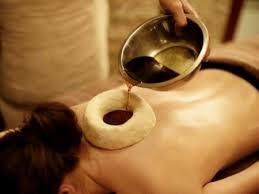
Benefits of Ayurvedic griva basti procedures include:
- Relief from neck pain: Griva basti is highly effective in relieving neck pain, stiffness, and discomfort caused by muscle tension, strain, poor posture, or cervical spondylosis.
- Improved flexibility: The warm oil used in griva basti helps to relax and loosen tight muscles, improving flexibility and range of motion in the neck area.
- Reduced inflammation: Ayurvedic herbs infused in the oil or decoction used in griva basti possess anti-inflammatory properties, which help reduce inflammation and swelling in the neck region.
- Nourishment of tissues: The warm medicated oil penetrates deeply into the tissues of the neck, nourishing the muscles, ligaments, tendons, and nerves, promoting their health and vitality.
- Relief from headaches: Griva basti can help alleviate tension headaches and migraines by releasing tension in the neck muscles and improving blood circulation to the head.
- Support for cervical conditions: This therapy is beneficial for various cervical spine conditions, including cervical spondylosis, cervical disc herniation, cervical radiculopathy, and cervical osteoarthritis.
- Stress relief: The calming and grounding effect of griva basti can help reduce stress and anxiety, promoting relaxation and mental well-being.
- Improved sleep: By relieving neck tension and promoting relaxation, griva basti can improve sleep quality and help alleviate insomnia.
Overall, Ayurvedic griva basti offers a natural and holistic approach to relieving neck pain and promoting neck health, addressing the root cause of discomfort and promoting overall well-being. It is essential to undergo griva basti therapy under the guidance of a qualified Ayurvedic practitioner to ensure safety and effectiveness.
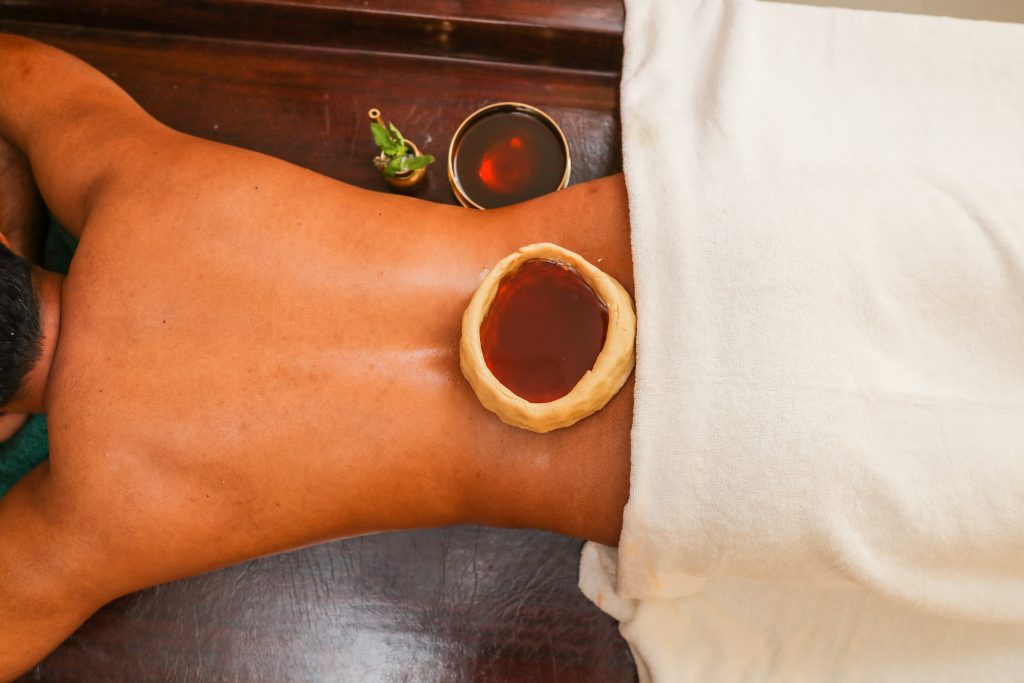
Ayurvedic Kati Basti
Kati Basti, an Ayurvedic therapy, focuses on the lower back or lumbosacral region. Let’s explore the process and benefits:
- Process:
- Dough Preparation: A thick dough is made using black gram paste.
- Custom Shape: The dough’s shape (circular, oval, or rectangular) corresponds to the area of the back that needs treatment.
- Application: The patient lies face down, and the dough is placed as a rim around the back. Water secures the edges to prevent slipping.
- Oil Reservoir: Medicated oil (selected based on the patient’s dosha) is warmed and poured into the dough ring, creating an oil reservoir.
- Therapeutic Properties: The oil’s therapeutic properties permeate the tissues, promoting healing and nourishment.
- Sustained Warmth: Regular replenishment maintains the warmth of the oil.
- Benefits:
- Lower Back Pain Relief: Kati Basti helps with lumbar spondylitis, intervertebral disc prolapses, lumbago, and sciatica.
- Muscle and Tissue Strengthening: Herbal oils nourish and strengthen muscles and tissues in the covered area.
- Joint Lubrication: The absorbed oils may lubricate joints, improving mobility and flexibility.
- Improved Blood Circulation: Enhances blood flow in the back.
- Spinal Strength: Prevents back pain and strengthens the spine.
- Relaxation and Muscular Support: Supports the affected intervertebral joint musculature.
- Holistic Well-Being: Part of the umbrella treatment Panchakarma, promoting overall health.

A Body Wrap
A body wrap is a spa treatment that involves wrapping the body in a mixture of ingredients, such as clay, algae, mud, seaweed, or herbal extracts, to detoxify, hydrate, and nourish the skin. The process typically includes the following steps:
- Exfoliation: Before the body wrap, the skin is usually exfoliated to remove dead skin cells and prepare the skin for better absorption of the wrap ingredients. This may involve dry brushing, a scrub, or a gentle exfoliating treatment.
- Application of wrap: The wrap mixture is applied to the skin, either directly or after being heated or mixed with water. The entire body or specific areas may be targeted, depending on the client’s preferences and the goals of the treatment.
- Wrapping: The body is wrapped in plastic or cloth bandages to help retain heat and moisture, allowing the ingredients in the wrap to penetrate the skin more deeply. The client may then be covered with towels or blankets to promote relaxation and enhance the effects of the wrap.
- Relaxation: While the wrap is on, the client typically relaxes on a comfortable surface, such as a heated massage table or a spa bed. Soft music, dim lighting, and aromatherapy may be used to enhance the relaxation experience.
- Duration: The duration of the wrap varies depending on the type of wrap and the desired results. Some wraps may be left on for 20-30 minutes, while others may be left on for longer periods.
- Removal and hydration: After the allotted time, the wrap is removed, and any remaining residue is gently wiped away. The skin may then be moisturized with a hydrating lotion or oil to lock in moisture and further nourish the skin.
The benefits of a body wrap include:
- Detoxification: Many body wrap ingredients, such as clay, algae, and seaweed, are known for their detoxifying properties, helping to draw out impurities and toxins from the skin.
- Hydration: Body wraps often contain moisturizing ingredients that help to hydrate and nourish the skin, leaving it feeling soft, smooth, and rejuvenated.
- Skin tightening and toning: Some body wraps claim to have skin-firming and toning effects, helping to improve the appearance of cellulite and tighten loose skin.
- Relaxation: The process of being wrapped up and left to relax can be deeply calming and soothing, promoting stress relief and overall well-being.
- Improved circulation: The heat generated by some body wraps can help to increase blood flow to the skin, promoting circulation and delivering nutrients to the tissues.
- Temporary inch loss: While the effects are usually temporary, some body wraps claim to help reduce inches from the body by drawing out excess fluids and toxins.
Overall, a body wrap can be a luxurious and rejuvenating spa treatment that leaves the skin feeling refreshed, hydrated, and revitalized.
A Full Body Scrub
A full body scrub is a spa treatment that involves exfoliating the skin to remove dead skin cells and reveal smoother, softer skin underneath. The procedure typically involves the following steps
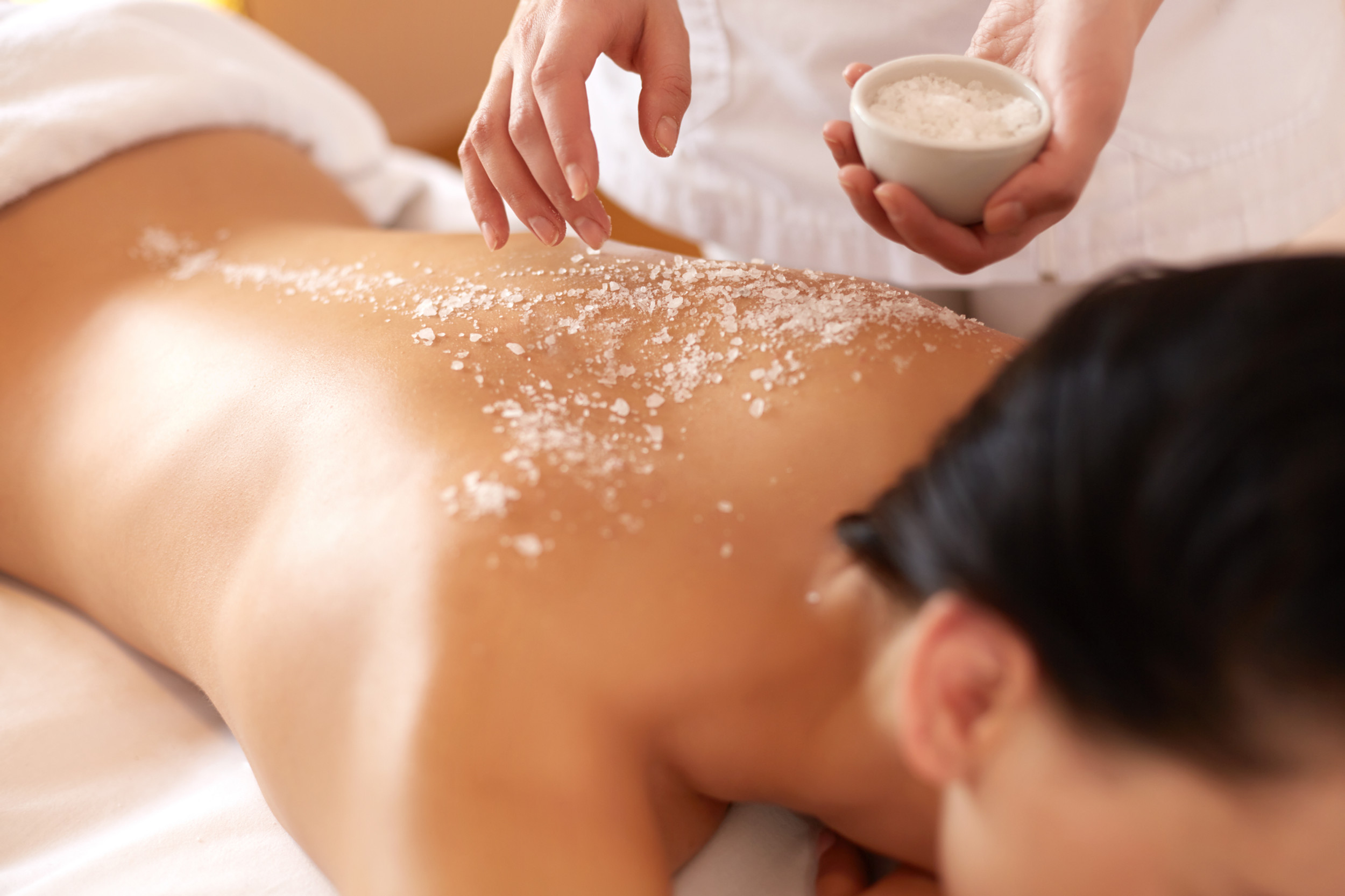
- Preparation: The client will be wiped with hot moist towels to cleanse their skin before the treatment This helps to remove any oils, lotions, or impurities from the skin, allowing the scrub to be more effective.
- Application of scrub: The client lies on a massage table, and the therapist applies a scrub or exfoliating product to the skin. The scrub may contain ingredients such as salt, sugar, coffee grounds, or crushed fruit seeds, mixed with oils or moisturizers to help nourish the skin.
- Massage and exfoliation: The therapist gently massages the scrub into the skin using circular motions, focusing on areas prone to dryness or roughness, such as the elbows, knees, and feet. The abrasive texture of the scrub helps to slough off dead skin cells, revealing smoother, softer skin.
- Rinsing: After the scrub as been applied and massaged into the skin,the client is usually going to be wiped with hot moist towel to wash away the scrub and any remaining dead skin cells.
- Moisturization: Once the skin has been thoroughly rinsed and dried, the therapist may apply a moisturizing lotion or oil to the skin to hydrate and nourish it, leaving it feeling soft and smooth.
The benefits of a full body scrub include:
- Exfoliation: Removes dead skin cells, promoting cell turnover and revealing fresher, brighter skin underneath.
- Improved skin texture: Smoothes rough or uneven skin texture, leaving skin feeling softer and more supple.
- Enhanced circulation: The massage and exfoliation stimulate blood flow to the skin, promoting a healthy glow and improving overall circulation.
- Stress relief: The gentle massage and pampering experience of a body scrub can help promote relaxation and reduce stress levels.
- Detoxification: Exfoliating the skin helps to unclog pores and remove impurities, promoting detoxification and a clearer complexion.
- Preparation for other treatments: A body scrub can help prepare the skin for other spa treatments, such as massages or body wraps, by removing barriers and allowing products to penetrate more deeply.
Overall, a full body scrub is a rejuvenating and revitalizing spa treatment that can leave the skin looking and feeling refreshed, smoother, and more radiant.

Indian Head Massage
Indian Head Massage, also known as Champissage, is a traditional therapeutic practice rooted in Ayurvedic medicine. This massage technique focuses on the head, neck, shoulders, promoting relaxation and well-being. The treatment typically lasts between 30 to 60 minutes and involves a series of gentle yet firm kneading, tapping, and stroking movements. The practitioner uses herbal Ayurvedic oils.
The massage aims to release tension and promote the flow of energy (or “prana”) throughout the body. It often includes techniques that address specific pressure points and muscle groups, helping to alleviate stress and enhance overall health.
Benefits of Indian Head Massage:
- Stress Relief: One of the primary benefits of Indian Head Massage is its ability to reduce stress and anxiety. The calming techniques promote relaxation, helping to lower cortisol levels and improve mood.
- Improved Circulation: The massage stimulates blood flow to the scalp and neck, which can enhance oxygen delivery to the brain and improve overall circulation throughout the body.
- Relief from Tension and Pain: This massage effectively alleviates tension in the neck, shoulders, and head, making it beneficial for individuals suffering from headaches, migraines, or muscle stiffness.
- Enhanced Mental Clarity: By promoting relaxation and reducing stress, Indian Head Massage can improve concentration and mental clarity, making it easier to focus on tasks.
- Improved Sleep Quality: The relaxation induced by the massage can lead to better sleep patterns, helping those who struggle with insomnia or restless sleep.
- Hair and Scalp Health: The techniques used in Indian Head Massage can stimulate hair follicles and improve scalp health, potentially promoting hair growth and reducing dandruff.
- Emotional Balance: The holistic approach of Indian Head Massage can help balance emotions, providing a sense of well-being and emotional stability.
- Boosted Immune System: Regular sessions may enhance immune function by reducing stress levels and promoting overall relaxation, which is crucial for maintaining good health.
- Increased Energy Levels: Many clients report feeling revitalized and energized after a session, as the massage helps release blocked energy in the body.
- Convenience and Accessibility: Indian Head Massage can be performed in various settings, including homes, offices, or wellness centers, making it accessible for busy individuals seeking relaxation without needing a full-body massage.
Overall, Indian Head Massage is a holistic therapy that not only addresses physical tension but also nurtures mental and emotional well-being.
Couples Massage
A couples massage is a unique and intimate experience designed for partners to enjoy together in a serene and relaxing environment. This therapeutic session takes place in a tranquil room where both individuals receive massages simultaneously, performed by skilled therapists.
During the massage, each partner can choose their preferred type of massage—be it Swedish, deep tissue, or aromatherapy—allowing for a personalized experience that caters to their individual needs. The soothing ambiance, complete with soft music and calming scents, enhances the overall relaxation.

Couples massage not only promotes physical relaxation but also fosters emotional connection and intimacy. It provides an opportunity for partners to unwind together, share a peaceful moment, and strengthen their bond. Whether celebrating a special occasion or simply seeking quality time together, a couples massage is a delightful way to nurture both body and relationship.
